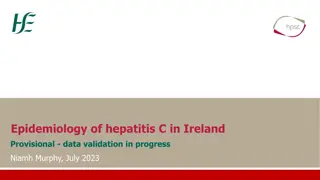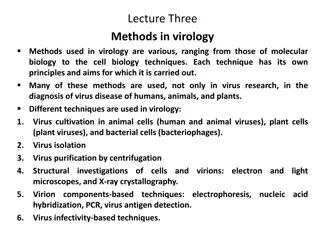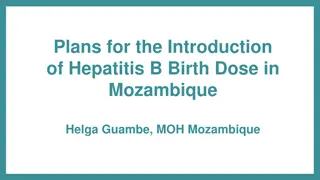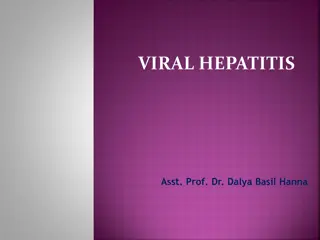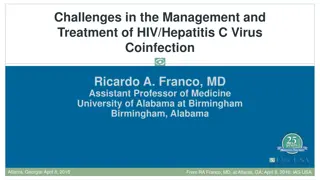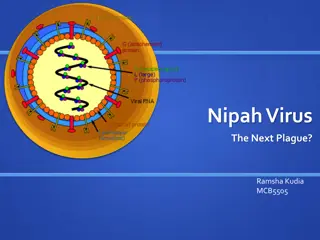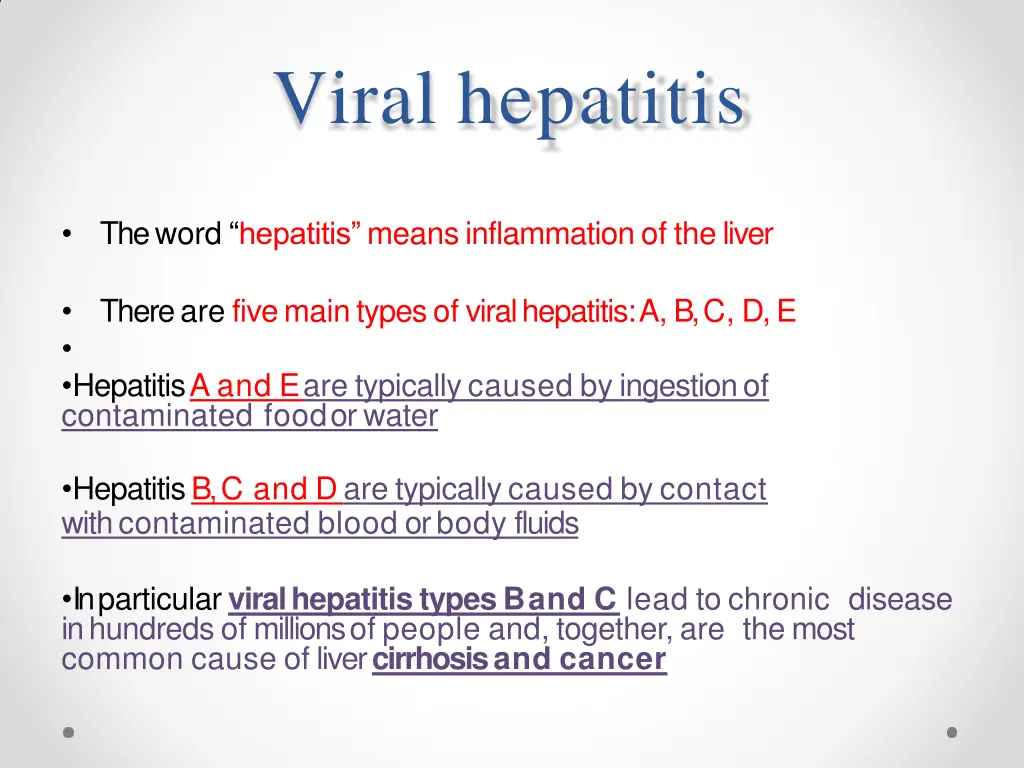
Understanding Viral Hepatitis: Types, Transmission, and Diagnosis
Learn about the five main types of viral hepatitis - A, B, C, D, and E. Discover how hepatitis is transmitted, particularly hepatitis B, and understand the structure of the hepatitis B virus. Explore laboratory diagnosis methods including liver chemistry tests and serology. Stay informed about this common liver disease to protect your health.
Download Presentation

Please find below an Image/Link to download the presentation.
The content on the website is provided AS IS for your information and personal use only. It may not be sold, licensed, or shared on other websites without obtaining consent from the author. If you encounter any issues during the download, it is possible that the publisher has removed the file from their server.
You are allowed to download the files provided on this website for personal or commercial use, subject to the condition that they are used lawfully. All files are the property of their respective owners.
The content on the website is provided AS IS for your information and personal use only. It may not be sold, licensed, or shared on other websites without obtaining consent from the author.
E N D
Presentation Transcript
Viral hepatitis Theword hepatitis meansinflammationof theliver Thereare fivemaintypesof viralhepatitis:A,B,C, D,E HepatitisA and Eare typicallycaused by ingestionof contaminated foodor water HepatitisB,C and Dare typicallycaused by contact withcontaminated blood orbody fluids InparticularviralhepatitistypesBand C lead to chronic disease inhundreds of millionsof people and, together,are the most common cause of livercirrhosisand cancer
Hepatitis B Virus (HBV) Hepatitis B causes acutehepatitis (short term and/or severe) and chronic infection(lingering-may not be severe) leading to chronic liver disease. The acute illness causes liver inflammation, jaundice( yellowing of the skin,eyes, etc) ,and (rarely) death. HBV istransmitted in blood, by sexual intercourse andfrom mother to child.
classification family : hepadnaviridae contains towgenera: 1-Genus :Orthohepadnavirus. 2-Genus: Avihepadnavirus.
Structure and genome Spherical, enveloped virion, 42 nm, enclosing inner icosahedral 27 nm nucleocapsid (core) composed of180 capsomeres Hepadnaviruses code for three major antigens, designated surface **(HBsAg), core (HBcAg), ande (HBeAg). *Envelope contains the glycoprotein, hepatitis B surface protein (HBsAg) of three different size species with common C-termini, L-, M-, and S-HBsAg *Core contains the phosphoprotein, hepatitis B core protein HBcAg, plus polymerase with three enzymeactivities: reverse transcriptase, DNApolymerase, and RNase Virions and subviral particles of hepatitis B virus. (A) Negative contrast electron microscopy of purified intact (B) Negative contrast electron microscopy of subviral particles hepatitis B surface protein (HBsAg) (C) Model of an intact virion and subviral particles showing constituents.
Laboratory diagnosis 1-Liver Chemistrytests: AST ,AL T ,ALP ,and totalBilirubin(rise in acute phase) alanine transaminase (ALT) and aspartate transaminase (AST), alkaline phosphatase (ALP), (Enzymes-Liver Function) 2-Serology: 1-BY using ELISA detectviral antigens or antibodies 1)HBsAg :-Itisthe firstmarker to appear in blood after infection. 2) Anti-HBs(HBsAb):- Disappearance of HBsAg and the appearance of anti-HBssignals recovery from HBV infection, non-infectivity.
2- Serology: 1-BY using ELISA 3) Anti-HBc :- IgM anti-HBc appears shortly after HBsAg is detect (HBcAg alone dose not appear in serum) IgM-HBc may also or can persist for 3-6 months or longer. IgG-HBc also appear during acute hepatitis B but persist indefinitely. 4) HBeAg :- HBeAg appear in blood concurrently with HBsAg, or soon afterwards. HBeAg indicate viral replication and infectivity.
2-By usingRadio-immunoassay Thistechnique uses an immune reaction [Antigen Antibody reaction] to estimate a ligand Ag +Ag* +Ab AgAb + Ag*Ab + Ag + Ab* A mixture isprepared of radioactive antigen and antibodies against thatantigen. Known amounts of unlabeled ("cold") antigen are added to samples of the mixture. These compete for the binding sitesof the antibodies. At increasing concentrations of unlabeled antigen, an increasing amount of radioactive antigen is displaced from the antibody molecules. The antibody-bound antigen is separated from the free antigen in the supernatant fluid, and the radioactivity of each ismeasured by Gamma Counter
https://www.youtube.com/watch?v=Cs1 LvCyEGKg From 1 to 4 min (Basic principle)
3-PCR :to measure the amount of HBV DNA 4 -Liver Biopsy: to determine grade(Inflammation) and stage(Fibrosis) in chronic Hepatitis 5-Isolation :HBV replication in primary cultures of human hepatocytes, but virus culture impracticable for routine diagnosticuse.
Prevention vaccination: highly effective recombinantvaccines. Hepatitis B immunoglobulin (HBIG|): exposed within 48 hours of the incident/neonates whose mothers are HBsAg and HBeAg positive. Other measures: screening of blood donors, blood and body fluid precautions.
Treatment Acute hepatitis Binfection does not usually require treatment because most adults clear the infection spontaneously . On the other hand, treatment of chronic infection may be necessary to reduce the risk of cirrhosis and liver cancer. Although none of the available drugs can clear the infection, they can stop the virusfrom replicating, thus minimizing liverdamage. Antiviral drugs lamivudine (Epivir), adefovir (Hepsera), tenofovir (Viread), interferon alpha-2a

